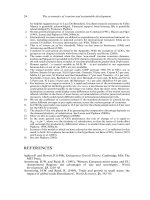THE ECONOMICS OF MONEY,BANKING, AND FINANCIAL MARKETS 362
Bạn đang xem bản rút gọn của tài liệu. Xem và tải ngay bản đầy đủ của tài liệu tại đây (31.46 KB, 1 trang )
330
PA R T I V
The Management of Financial Institutions
As we discussed in the previous chapter, there was a major boom and bust in
the U.S. housing market that led to huge losses for banks around the world from
their holdings of securities backed by U.S. residential mortgages. In addition,
banks had to take back onto their balance sheets many of the structured investment vehicles (SIVs) they had sponsored. The losses reduced bank capital and
increased the need for more capital to support the assets coming back onto bank
balance sheets. This led to capital shortfalls: banks had to either raise new capital
or restrict asset growth by cutting back on lending. Banks did raise some capital
but with the growing weakness of the world economy, raising new capital was
extremely difficult, so the banks chose the latter course. Banks tightened their
lending standards and restricted lending, both of which helped produce a weak
economy in 2008 and 2009.
MAN AG I N G CRE DI T RI SK
As seen in the earlier discussion of general principles of asset management, banks
and other financial institutions must make successful loans that are paid back in
full (and so subject the institution to little credit risk) if they are to earn high profits. The economic concepts of adverse selection and moral hazard discussed in
Chapters 2 and 8 provide a framework for understanding the principles that financial institutions have to follow to reduce credit risk and make successful loans.
Adverse selection in loan markets occurs because bad credit risks (those most
likely to default) are the ones who usually line up for loans in other words, those
who are most likely to produce an adverse outcome are the most likely to be
selected. Borrowers with very risky investment projects have much to gain if their
projects are successful, and so they are the most eager to obtain loans. Clearly, however, they are the least desirable borrowers because of the greater possibility that
they will be unable to pay back their loans.
Moral hazard is a problem in loan markets because borrowers may have
incentives to engage in activities that are undesirable from the lender s point
of view. In such situations, it is more likely that the lender will be exposed to the
hazard of default. Once borrowers have obtained a loan, they are more likely to
invest in high-risk investment projects projects that pay high returns to the borrowers if successful. The high risk, however, makes it less likely that they will be
able to pay the loan back.
To be profitable, financial institutions must overcome the adverse selection
and moral hazard problems that make loan defaults more likely. The attempts of
financial institutions to solve these problems help explain a number of principles
for managing credit risk: screening and monitoring, establishment of long-term
customer relationships, loan commitments, collateral and compensating balance
requirements, and credit rationing.
Screening
and
Monitoring
Asymmetric information is present in loan markets because lenders have less information about the investment opportunities and activities of borrowers than borrowers do. This situation leads to two information-producing activities by financial
institutions: screening and monitoring.









